Tom Kepler's Blog, page 28
November 29, 2012
Advice About Deer Crossing Road Safety: A Funny Story
Just a conversation to keep everything in perspective. After all, knowledge is structured in consciousness! (Found on Facebook)

Published on November 29, 2012 03:30
November 24, 2012
To Be a Man, To Be a Woman, One Must First be Human
 Yes, this is a pretentious title, so let me admit to that up front.
Yes, this is a pretentious title, so let me admit to that up front.Having said that, I do think I have something to say on this subject, having practiced the Transcendental Meditation technique for forty years, being a teacher of the TM technique, having taught in the classroom and studied learning theory for thirty-five years, and . . . well, having lived in a human body for sixty years. And, of course, I happen to have this blog . . .
I am thinking of water, two atoms hydrogen, one atom oxygen. The liquid form, water, changes to vapor or ice because of temperature; activity is increased or lessened by temperature. The forms of water, though, are always the same. The laws of nature structure that activity. The steam can freely move through a kitchen from a bubbling pot, or it can be contained in a pressure cooker. Ice can form as freely as the winter stream flows, or it can be molded into cubes by the ice tray in the freezer. The reality of two atoms hydrogen and one atom oxygen remains the same, though.
All of existence consists of creative dynamism, creative intelligence, manifesting into all the diversity of the universe, from the swirls and clusters of galaxies to the bits and pieces of atoms. All this merges to the wholeness of existence according to the laws of nature. There is an order to even the most undisciplined event and a wildness within even the most confining of circumstances. What we want on our brief time on earth is more a whim than a will, like comparing human age to geologic age. Humans designed the Fukushima power plant in Japan to withstand size 7.0 tremors ( Telegraph ); the earthquake that hit was a magnitude of 8.9 ( Los Angeles Times ). If living our lives is our "job," then we must consider our hours on earth not only by the human "clock" but also by the cosmic "clock." Our actions outlive us.
We are both human and cosmic; man or woman, we are cosmic. We transcend duality; that is our true humanity. That is the beginning place for defining ourselves. What a man wants or what a woman wants arises from the source of thought, pure consciousness, and that fount of existence is the same that structures stone and air and fire and water and space itself. We are cosmic first and foremost, and we structure our lives within our bodies, male and female. As a teacher, I can see that any program that seeks to take "boys to men" or "girls to women" without considering that humanity arises from the same cosmic womb that births the entire universe--that we are that, would be a program destined to limited success.
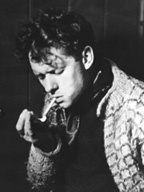 Welsh poet Dylan Thomas expressed this well in his poem "The Force That Through the Green Fuse Drives the Flower": The force that through the green fuse drives the flower/Drives my green age . . . The five stanzas of the poem develop the cosmic essence of our existence. The poem also tells how this connection cannot be explained. It is not an idea; this connection is the essence of existence and can only be experienced. And I am dumb to tell . . . the poet explains. Words find difficulty describing the Wordless. Dylan Thomas's life was a tragic example of what it means to intuitively know one's true self yet to not be able to truly live that.
Welsh poet Dylan Thomas expressed this well in his poem "The Force That Through the Green Fuse Drives the Flower": The force that through the green fuse drives the flower/Drives my green age . . . The five stanzas of the poem develop the cosmic essence of our existence. The poem also tells how this connection cannot be explained. It is not an idea; this connection is the essence of existence and can only be experienced. And I am dumb to tell . . . the poet explains. Words find difficulty describing the Wordless. Dylan Thomas's life was a tragic example of what it means to intuitively know one's true self yet to not be able to truly live that.I have found practicing Transcendental Meditation a nurturing means of experiencing who I am--a simple, easy, and natural technique. Growing up as a poet, I was lucky to learn TM a week before my twenty-first birthday. Otherwise, I would have followed the rich tradition of the artist and poet: hitting bottom before starting for the top, experiencing the dark night of the soul. I have sunk low enough, experienced enough the dark obscurity of my ignorance, that I have found great motivation in seeking a more positive, nurturing way to find myself.
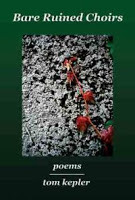 This is what I see . . . is how I started a poem when I was nineteen years old. I'm glad I've had an opportunity to write about what I see, rather than about my lack of vision.
This is what I see . . . is how I started a poem when I was nineteen years old. I'm glad I've had an opportunity to write about what I see, rather than about my lack of vision.We are all expressions of existence, of consciousness. That seems to be a good place to meet, men and women, humanity and all of diversity.
Copyright 2012 by Thomas L. Kepler, all rights reserved
Published on November 24, 2012 05:10
November 22, 2012
I Almost Buy a Motorcycle--This Week!
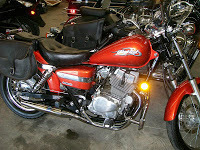 At C & C Cycle in CharitonIt's true--I was thinking about buying a motorcycle.
At C & C Cycle in CharitonIt's true--I was thinking about buying a motorcycle.I owned a Honda 250 Scrambler back in 1970--right until I was in a motorcycle accident. Then I sold my motorcycle, my sports car (an Austin Healey), and bought a Cadillac--a tank of a car. Perhaps this was an over-reaction, but I had received substantial proof of my mortality. Even at eighteen years of age I got the message. Besides, the Austin Healey, a great sports car, was also, unfortunately, a completely worn out piece of junk.
 When I owned a motorcycle, I loved the sensational experience of riding it--in the literal meaning of the word sensational. Riding a motorcycle is a physical, sensory-stimulating experience. Think of a dog with its head out the car window.
When I owned a motorcycle, I loved the sensational experience of riding it--in the literal meaning of the word sensational. Riding a motorcycle is a physical, sensory-stimulating experience. Think of a dog with its head out the car window.However, I also have the memory of that car pulling out in front of me and I having nowhere to go. I remember asking my parents, "Why did you let me buy a motorcycle?" as I sat at the emergency ward, my elbow burst through the skin. My mortality and my responsibility to my family comprised part of my choice not to buy a motorcycle.
The other half of my choice was just plain logic. I know that if I bought a motorcycle, I wouldn't go for long rides or extended trips. It would be almost completely for zipping around town. Ten or fifteen minutes of riding my bike gets me anywhere in town. Then question is this: Why buy and maintain a motorcycle to do what I already can do with my bicycle, with greater health benefits and with no petrochemical environmental downside? I had to admit there were no good reasons for buying a motorcycle, considering my needs--only cool reasons.
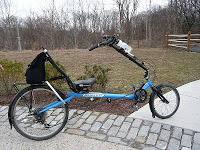 I could have argued with myself that one is no safer on a bicycle than on a motorcycle, but that isn't entirely true. The greater speed lessens reaction time for both motorcyclist and car driver. The greater speed increases whatever impacts might occur from losing control. A bicyclist just has more time to make decisions, and if that decision is to head for the ditch, at least it's not at 25+ MPH. My Burley Koosah recumbent bike is also easier on my body when I ride than a regular diamond frame bicycle; it's more upright, like a motorcycle, and doesn't have that tiny little seat.
I could have argued with myself that one is no safer on a bicycle than on a motorcycle, but that isn't entirely true. The greater speed lessens reaction time for both motorcyclist and car driver. The greater speed increases whatever impacts might occur from losing control. A bicyclist just has more time to make decisions, and if that decision is to head for the ditch, at least it's not at 25+ MPH. My Burley Koosah recumbent bike is also easier on my body when I ride than a regular diamond frame bicycle; it's more upright, like a motorcycle, and doesn't have that tiny little seat.Still, that orange Honda Rebel--the current equivalent of the old Honda 250, is one great-looking bike! Sometimes, though, the memories are better than the realities. I'd be uncomfortable thinking of my wife or son on a motorcycle. I'd worry about crashes. Why should I put my family through that? Or the possibility of that? Better to ride my bike and take to the Jefferson County bike trails system.
It's a joy I can live with.
Copyright 2012 by Thomas L. Kepler, all rights reserved
Published on November 22, 2012 04:00
November 20, 2012
Tom Kepler Writing: Thanksgiving Week Free Downloads
For the week of Thanksgiving, I am offering free downloads of my books that are available at Smashwords.
I am thankful to have the opportunity to make my books available, and I'm happy to share this offer with my readers.
The procedure for a free download at Smashwords is to link to the book's page (link provided below), and then "buy" the book, using the coupon code in order to download the book for free.
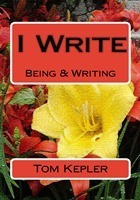
I Write: Being and Writing : My latest book, this is a compilation and rewrite of blog posts about writing. I address the relationship between the writer, the process of writing, and the written word. The coupon code for a free download is TV99H.
"I write." We have to consider both words in that declaration. We have to expand the container of knowledge, the mind, and also develop our writing skills. Learning how to write is a life-long process. It is one that demands dedication and humility and perseverance. It is one that requires a certain knack that is an integration of skill and comprehensive thinking. One might say, "As we are, so is our writing."
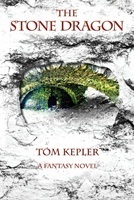 The Stone Dragon
: This is my fantasy novel that could be called "consciousness-based" fantasy because it explores the relationship between consciousness and magic. The coupon code for a free download is WR28H.
The Stone Dragon
: This is my fantasy novel that could be called "consciousness-based" fantasy because it explores the relationship between consciousness and magic. The coupon code for a free download is WR28H.
Dream magic is the most dangerous of magics because it is so difficult to control. Apprentice mage Glimmer—Not a Glimmer of Magic—realizes this when he discovers that his apparent lack of magical talent is because his magic manifests only when he is dreaming. His first attempt at dream magery conjures a dragon, and just before dying in dragonfire, Glimmer, in desperation, locks the dragon within the stones of his master’s house. How, though, do you live in a house that is also a dragon? And how can you even sleep—knowing that dream might slip to nightmare?
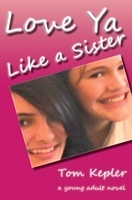 Love Ya Like a Sister
: Be your own man. That’s what people say. But what if that includes having three girlfriends at the same time—and trouble with the law? My first novel published, LYLAS takes a "gritty" look at the world of teens, a young adult novel for grown-ups (in the words of two reviewers). The conflicts in the novel are met by a young man and his friends, and family, friendship, and personal integrity ultimately prevail. The coupon code for a free download is WG57A.
Love Ya Like a Sister
: Be your own man. That’s what people say. But what if that includes having three girlfriends at the same time—and trouble with the law? My first novel published, LYLAS takes a "gritty" look at the world of teens, a young adult novel for grown-ups (in the words of two reviewers). The conflicts in the novel are met by a young man and his friends, and family, friendship, and personal integrity ultimately prevail. The coupon code for a free download is WG57A.
"The author has described Love Ya Like a Sister as young adult chick lit with a male protagonist. While that seems like a strange description, it’s a good one. Although chick lit should have a protagonist who is a chick, that is the only reason this book couldn’t be considered chick lit. It has the other defining elements, primarily being 'a personal and foible-filled journey toward self-understanding and self-awareness.'" Big Al's Books and Pals
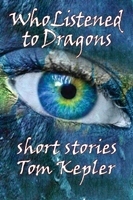 Who Listened to Dragons, Three Stories
: Set in the same reality as the fantasy novel The Stone Dragon, three short stories continue the magic of the novel. Two brothers--one the strange one, the other the brother of the strange one, desert and wyrm, river's daughters or river nymphs, soldiers or assassins, retribution or abomination . . . Visit a land where magic makes all things are possible.
Who Listened to Dragons, Three Stories
: Set in the same reality as the fantasy novel The Stone Dragon, three short stories continue the magic of the novel. Two brothers--one the strange one, the other the brother of the strange one, desert and wyrm, river's daughters or river nymphs, soldiers or assassins, retribution or abomination . . . Visit a land where magic makes all things are possible.
I enjoyed exploring other possibilities in this universe, considering magic, geography, and history. I plan to eventually write more short stories for this series. The coupon code for a free download is XP37E.
"[The stories] silently work their way into your brain so that odd images and thoughts and layers of meaning hover around like smoke for days afterwards. Highly recommended." Goodreads Review
May you all have a happy and restful holiday, and if you enjoy reading my books, please write some reviews. Many thanks.
Copyright 2012 by Thomas L. Kepler, all rights reserved

I am thankful to have the opportunity to make my books available, and I'm happy to share this offer with my readers.
The procedure for a free download at Smashwords is to link to the book's page (link provided below), and then "buy" the book, using the coupon code in order to download the book for free.

I Write: Being and Writing : My latest book, this is a compilation and rewrite of blog posts about writing. I address the relationship between the writer, the process of writing, and the written word. The coupon code for a free download is TV99H.
"I write." We have to consider both words in that declaration. We have to expand the container of knowledge, the mind, and also develop our writing skills. Learning how to write is a life-long process. It is one that demands dedication and humility and perseverance. It is one that requires a certain knack that is an integration of skill and comprehensive thinking. One might say, "As we are, so is our writing."
 The Stone Dragon
: This is my fantasy novel that could be called "consciousness-based" fantasy because it explores the relationship between consciousness and magic. The coupon code for a free download is WR28H.
The Stone Dragon
: This is my fantasy novel that could be called "consciousness-based" fantasy because it explores the relationship between consciousness and magic. The coupon code for a free download is WR28H.Dream magic is the most dangerous of magics because it is so difficult to control. Apprentice mage Glimmer—Not a Glimmer of Magic—realizes this when he discovers that his apparent lack of magical talent is because his magic manifests only when he is dreaming. His first attempt at dream magery conjures a dragon, and just before dying in dragonfire, Glimmer, in desperation, locks the dragon within the stones of his master’s house. How, though, do you live in a house that is also a dragon? And how can you even sleep—knowing that dream might slip to nightmare?
 Love Ya Like a Sister
: Be your own man. That’s what people say. But what if that includes having three girlfriends at the same time—and trouble with the law? My first novel published, LYLAS takes a "gritty" look at the world of teens, a young adult novel for grown-ups (in the words of two reviewers). The conflicts in the novel are met by a young man and his friends, and family, friendship, and personal integrity ultimately prevail. The coupon code for a free download is WG57A.
Love Ya Like a Sister
: Be your own man. That’s what people say. But what if that includes having three girlfriends at the same time—and trouble with the law? My first novel published, LYLAS takes a "gritty" look at the world of teens, a young adult novel for grown-ups (in the words of two reviewers). The conflicts in the novel are met by a young man and his friends, and family, friendship, and personal integrity ultimately prevail. The coupon code for a free download is WG57A."The author has described Love Ya Like a Sister as young adult chick lit with a male protagonist. While that seems like a strange description, it’s a good one. Although chick lit should have a protagonist who is a chick, that is the only reason this book couldn’t be considered chick lit. It has the other defining elements, primarily being 'a personal and foible-filled journey toward self-understanding and self-awareness.'" Big Al's Books and Pals
 Who Listened to Dragons, Three Stories
: Set in the same reality as the fantasy novel The Stone Dragon, three short stories continue the magic of the novel. Two brothers--one the strange one, the other the brother of the strange one, desert and wyrm, river's daughters or river nymphs, soldiers or assassins, retribution or abomination . . . Visit a land where magic makes all things are possible.
Who Listened to Dragons, Three Stories
: Set in the same reality as the fantasy novel The Stone Dragon, three short stories continue the magic of the novel. Two brothers--one the strange one, the other the brother of the strange one, desert and wyrm, river's daughters or river nymphs, soldiers or assassins, retribution or abomination . . . Visit a land where magic makes all things are possible. I enjoyed exploring other possibilities in this universe, considering magic, geography, and history. I plan to eventually write more short stories for this series. The coupon code for a free download is XP37E.
"[The stories] silently work their way into your brain so that odd images and thoughts and layers of meaning hover around like smoke for days afterwards. Highly recommended." Goodreads Review
May you all have a happy and restful holiday, and if you enjoy reading my books, please write some reviews. Many thanks.
Copyright 2012 by Thomas L. Kepler, all rights reserved
Published on November 20, 2012 04:29
November 17, 2012
On Becoming a Man: Variations on a Theme
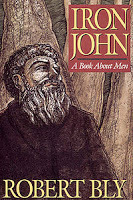 I have been thinking about Robert Bly's book
Iron John: A Book About Men
, now that I am teaching British literature again. This has led me to another book, one that I haven't in my hand yet, but one I've that seems provocative, Hammering Hot Iron: A Spiritual Critique of Bly's Iron John.
I have been thinking about Robert Bly's book
Iron John: A Book About Men
, now that I am teaching British literature again. This has led me to another book, one that I haven't in my hand yet, but one I've that seems provocative, Hammering Hot Iron: A Spiritual Critique of Bly's Iron John.Poet Robert Bly's Iron John in the preface says that "the images of adult manhood given by the popular culture are worn out" and then provides new interpretations of what it means to be a man, "new visions of what a man is or could be." Certainly we need to go beyond the stereotype of a man as one who stifles feeling and uses violence and death as the # 1 go-to for solving conflict.
In Bly's preface to Iron John, Bly states: "There is male initiation, female initiation, and human initiation. In this book I am talking about male initiation only." He continues by saying that the book is not a reaction against the women's movement but rather an addition to the movement of men to understand themselves, each exploration moving "on a separate timetable."
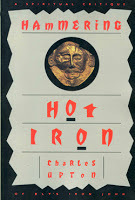 Charles Upton, another poet, wrote Hammering Iron John in an attempt to extend the vision of what it means to be a man as more importantly a quest to discover what it means to be human. J. Gomez, Amazon reviewer writes the following: "Upton writes: '. . . Bly states that his intention is to talk about male initiation alone. My intention is to try and situate this initiation in its greater context, that of the attainment of the fully human state.'"
Charles Upton, another poet, wrote Hammering Iron John in an attempt to extend the vision of what it means to be a man as more importantly a quest to discover what it means to be human. J. Gomez, Amazon reviewer writes the following: "Upton writes: '. . . Bly states that his intention is to talk about male initiation alone. My intention is to try and situate this initiation in its greater context, that of the attainment of the fully human state.'"From reading passages with the "Look Inside" function at Amazon, it appears that Upton's prose style is denser and more rambling than Bly's. However, his ideas do indeed stimulate thought, enriching the reading of Bly's Iron John. He mentions that one attempt by men to embrace their greater selves was to embrace the concept of the earth mother, but to embrace the All-Mother through loving the earth through the senses, what men ended up with "was a goddess too big to marry and too indifferent and impersonal to act as the protective mother we hoped she would be for us, the nurturing bosom that would shield us against the negative father-world of raw technological society."
Upton continues in the next paragraph:
"The lesson we needed to learn was that the Great Mother as an image is not the same thing as the Earth as an experience. We 'come to our senses' not by worshiping the idea of sense-experience, even in the most idyllic surroundings, but by quieting the mind." (from "The Rejection of Transcendence")Who can be the mentor to initiate a man into his own masculinity? How can a man find himself? This is the theme of both books. Perhaps Bly chose his tight focus on men finding themselves because of what he perceived as the need of the times. I remember one powerful passage in Bly's book where he mentions myths of the Earth Father that have been lost or overlooked through time. I like the idea of man being a steward to the earth. Upton reacts from his experience, including in his book reference to his experiences in the 60's and 70's and his disenchantment with the limitations of many of the movements of his times. He takes these experiences, though, and synthesizes them into a vision
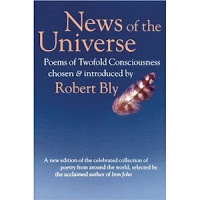 Robert Bly is certainly aware of transcendence as a mean of finding our humanity, our connection with the universe, and therefore our "maleness" or "femaleness." He edited and introduced the poetry anthology
News of the Universe: Poems of Twofold Consciousness
in 1980, ten years before Iron John. In the anthology, he includes poems "in which the human consciousness, though present, becomes transparent." He includes poems about the "struggle to open the consciousness-door" and poems that "suggest a certain unity of consciousness that we haven't arrived at yet," that older cultures expressed in poetry "a deeper union than the post-Industrial Revolution psyche has yet achieved."
Robert Bly is certainly aware of transcendence as a mean of finding our humanity, our connection with the universe, and therefore our "maleness" or "femaleness." He edited and introduced the poetry anthology
News of the Universe: Poems of Twofold Consciousness
in 1980, ten years before Iron John. In the anthology, he includes poems "in which the human consciousness, though present, becomes transparent." He includes poems about the "struggle to open the consciousness-door" and poems that "suggest a certain unity of consciousness that we haven't arrived at yet," that older cultures expressed in poetry "a deeper union than the post-Industrial Revolution psyche has yet achieved."I guess this is why I practice the Transcendental Meditation technique and why so many of us are seeking knowledge of who we are. By finding the Self, that which is beyond duality, neither man or woman but the essence of both, we can then step onto the platform that our body and life's work give us and act--as a man, a wo-man, or a hu-man.
In the epilogue to Hammering Hot Iron, Charles Upton ends with a poem entitled "To Robert":
You call--I answer with an echo/The shape of the broken cliff that birthed me,/The shape of your voice./If ever your loveWe are who we are, and may God bless us with self-knowledge and happiness.
Copyright 2012 by Thomas L. Kepler, all rights reserved
Published on November 17, 2012 04:54
November 15, 2012
Book Review: Riversong, by Tess Hardwick
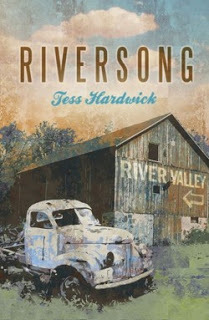 As a hero, Lee Tucker in the novel Riversong best fits the archetype of "orphan." She faces challenges and dangers that she is incapable of meeting. Or practically incapable, anyway; otherwise, it would be a really short novel.
As a hero, Lee Tucker in the novel Riversong best fits the archetype of "orphan." She faces challenges and dangers that she is incapable of meeting. Or practically incapable, anyway; otherwise, it would be a really short novel. The protagonist's insecurities and fears create a character locked or frozen when action is required, the reader watching her struggle with her demons and managing to do something at the last minute and thereby making it to the next page. I know this sounds rather unappealing, but Lee Tucker's struggles as described by author Tess Hardwick do inspire, and there are a number of reasons why--those reasons mainly being the secondary characters of the novel.
Ellen White is a retired English teacher, a no-nonsense lady who becomes Lee's mentor on her hero's journey. "She was dressed in a long skirt, a blouse buttoned up th her neck, square practical shoes . . . "Linus is the stereotypical gay sidekick, but Hardwick fills out this stereotype to three dimensions, portraying the character as true and brave, someone who is willing to take on pain for a friend.Mike Huller is a good-old-boy who really is good. He may wear a belt with a large buckle shaped like Oregon, but behind that is a man who cares about his son, his friends, and his town.Tommy Gonzalas is a musician who is more than a Hispanic beefcake. "The local hero. Rescues dogs, kids and recent widows." These words are said sarcastically by one of the novel's antagonists, but they are pretty true.These colorful characters and others, both supportive and adversarial, interact with Lee Tucker as she tries to splice together the strands of her fraying life, as described in the book's pitch at Booktrope.
Lee Tucker is the kind of woman you find yourself rooting for long after the last page is read. When her husband commits suicide, he leaves her pregnant and one million dollars in debt to a loan shark. Out of options, she escapes to her deceased mother’s dilapidated house located in a small Oregon town that, like her, is financially ruined, heartbroken and in desperate need of a fresh start. Lee’s resilience leads to a plan for a destination restaurant named Riversong, to new chances for passion and love, and to danger from her dead husband’s debt as her business blooms.
At times having too much backstory and too little editing (her publisher did her no favors with proofreading), Riversong nonetheless was a book I enjoyed reading. At first I thought it was a young adult story. Later, it morphed into a story about being "on the lam" from racketeers and drug users. Finally, it became a story of a woman battling the stresses of her past to find self-worth, the ability to trust, and love. Not a bad progression, even if there were a few moments of head scratching.
Riversong, in the final analysis, is a story of a small town, of a river, of commitment to friends and hope. I felt uplifted at the last page, ready to take on my challenges, happy to have friends watching my back.
Copyright 2012 by Thomas L. Kepler, all rights reserved
Published on November 15, 2012 04:00
November 13, 2012
Apple Bookstore Releases My Books
I have three eBooks distributed through the Apple Bookstore and should soon have four after my non-fiction work I Write: Being and Writing is processed.
I distribute my books to Apple through Smashwords. Apple manually checks additions, which takes about two weeks, according Smashwords.
Smashwords' November 3 blog post was "How to Sell Ebooks at the Apple iBookstore." The graphic below from the post demonstrates why authors should make sure to make available links to the iBookstore.
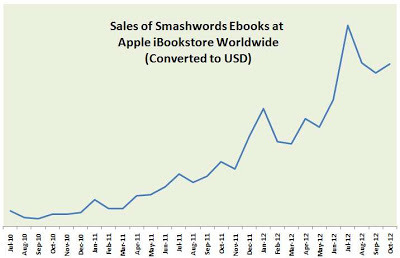
Mark Coker, CEO of Smashwords, provides six tips in the blog post on how to market a book at the iBookstore and at other outlets.
Here are the tips, short version:
Read Coker's free The Secrets to Ebook Publishing Success .Maintain an online presence at the Apple site. Persevere.Use Apple links, widgets, and buttons to promote your books on their site.Even a few sales helps because of the "Customers Also Bought" algorithm.Merchandising managers like many pleased customers, so sales and social media fans along with sales are always big attention-getters.Be positive, Coker emphasizes. "New York Times bestseller Jonathan Maberry said it best, here in his interview at the Smashwords blog: Think about a party. If there’s someone who is bitching and moaning and someone else who’s getting folks to laugh and loosen up, which way do you drift?" The tips that struck me as immediate needs and easily accomplished were to provide links and widgets to my eBooks available at Apple. I used the link- and widget-making tools to for my blog and book sites.
The links are now included with the list on the sidebar to the right of my blog posts. Widgets are included on the pages for each book. I found doing these two tasks easy and quick.
Here is a composite widget below:
If you read books through Apple electronic platforms, check mine out. I always like it when Smashwords sends me an email, letting me know that I've sold an eBook through their distribution channels.
Copyright 2012 by Thomas L. Kepler, all rights reserved
I distribute my books to Apple through Smashwords. Apple manually checks additions, which takes about two weeks, according Smashwords.
Smashwords' November 3 blog post was "How to Sell Ebooks at the Apple iBookstore." The graphic below from the post demonstrates why authors should make sure to make available links to the iBookstore.

Mark Coker, CEO of Smashwords, provides six tips in the blog post on how to market a book at the iBookstore and at other outlets.
Here are the tips, short version:
Read Coker's free The Secrets to Ebook Publishing Success .Maintain an online presence at the Apple site. Persevere.Use Apple links, widgets, and buttons to promote your books on their site.Even a few sales helps because of the "Customers Also Bought" algorithm.Merchandising managers like many pleased customers, so sales and social media fans along with sales are always big attention-getters.Be positive, Coker emphasizes. "New York Times bestseller Jonathan Maberry said it best, here in his interview at the Smashwords blog: Think about a party. If there’s someone who is bitching and moaning and someone else who’s getting folks to laugh and loosen up, which way do you drift?" The tips that struck me as immediate needs and easily accomplished were to provide links and widgets to my eBooks available at Apple. I used the link- and widget-making tools to for my blog and book sites.
The links are now included with the list on the sidebar to the right of my blog posts. Widgets are included on the pages for each book. I found doing these two tasks easy and quick.
Here is a composite widget below:
If you read books through Apple electronic platforms, check mine out. I always like it when Smashwords sends me an email, letting me know that I've sold an eBook through their distribution channels.
Copyright 2012 by Thomas L. Kepler, all rights reserved
Published on November 13, 2012 04:00
November 10, 2012
Book Review: The Rough Riders, by Theodore Roosevelt
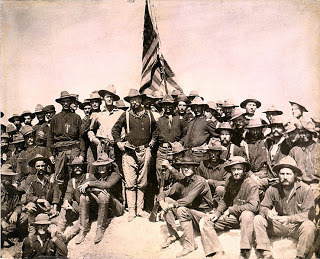 Rough Riders, Battle of San Juan, 1898 (Wikimedia Commons)A stereotype of the American man exists: a man of purity with a simple, straightforward manner of supporting right and opposing wrong with bravery and fortitude. There is also another side to that stereotype: a man whose simple perspective of right and wrong minimizes minorities and significant perspectives just because they don't fit into that simple world view.
Rough Riders, Battle of San Juan, 1898 (Wikimedia Commons)A stereotype of the American man exists: a man of purity with a simple, straightforward manner of supporting right and opposing wrong with bravery and fortitude. There is also another side to that stereotype: a man whose simple perspective of right and wrong minimizes minorities and significant perspectives just because they don't fit into that simple world view.I think Theodore Roosevelt and his era fit both sides of that stereotype of the American man, good and bad.
In 1898 the American government allowed for the raising of a volunteer fighting unit to assist the army during the Spanish-American War. Theodore Roosevelt was a key player in the raising and fighting of that unit, specifically of the 1st United States Volunteer Calvary. Three regiments were raised, but only the 1st actually went to Cuba and fought.
Roosevelt's The Rough Riders is his account of that fight, and it is written with Roosevelt's usual straightforward, highly readable prose style. Stated in an unemotional and "I was there" objective style, Roosevelt's account includes the sweep of history and also the nuts and bolts of the military campaign to whip the Spaniards in Cuba. The account begins with the raising of the regiments, their training, and their transport to Cuba. It describes the campaign with an eye focused on detail, events, and all the interesting and colorful men who volunteered and fought.
As with his book Through the Brazilian Wilderness, Roosevelt matter-of-factly depicts the great suffering contained within the events with words that describe the facts but eschew the emotions. That is to say, there is enough of a naturalist and journalist in him to describe in full what happened, but you aren't going to hear him whining about the horrendous nature of the circumstances.
When I wrote book reviews of Roosevelt's Through the Brazilian Wilderness and Candice Millard's chronicle The River of Doubt: Theodore Roosevelt's Darkest Journey, two accounts of the same event, one personal and the other scholarly, I discovered Roosevelt's penchant for baldly stating a difficult circumstance in his account--and then when reading Millard's account, discovering the great amount of detail that was left out by Roosevelt because he felt it would be too close to the emotional bone and might have been construed as whining or complaining. (Roosevelt mentions his disregard for whiners several times in The Rough Riders.)
Without whining, Roosevelt catalogs the United States' unpreparedness for the military campaign in Cuba.
Lack of adequate transportation, resulting in the suffering of troops and inadequate materiel.Front line shortages of food, medicine, clothing and shelter--almost everything but ammunition.Older weapons that smoked when fired, allowing Spain to fire upon gun placements with their placements that couldn't be located because of smokeless powder.However, the Americans prevailed, and Roosevelt describes the brave and selfless actions of his men and also of the regular army. He praises men educated and uneducated, men of different races and ethnic backgrounds. He looks upon them as individuals, and as the book progresses, we see that his judgment of the men as individuals earns him their respect. Even though Roosevelt writes this about himself, based on what I've read about him, I believe it to be true.
As we read about events written about from over a hundred years ago--as we read from an era when a Black American president has just been re-elected--we see that paradox of men who fought side by side, men of all races and backgrounds--men who judged one another on their individual manly qualities, and yet men who still were affected by and unconsciously promulgated the biases of the era.
Roosevelt praises the fighting abilities of the Black regular soldiers, yet the regulars were in a segregated regiment and led by white officers. He states that he was surprised that the Blacks were just as susceptible to malaria as whites; I assume his thinking was that since Blacks had come from Africa that there would be a genetic resistance to the disease. Roosevelt mentions casually all the officers who had been to the big schools in America--the Good Old Boy network--as just the way things were.
All these inequities are subsumed in the reality that these men of the Rough Riders lived and fought side by side in appalling conditions: fought, were wounded, and died with equal respect for bravery and perseverance, and with equal understanding that some men broke under the pressure and stress of the circumstances.
The Rough Riders paints a fascinating picture of a past time, a first-hand account written by a fascinating American. I downloaded my free eBook of The Rough Riders through the Kindle Store, but it is also available through Project Gutenberg.
Copyright 2012 by Thomas L. Kepler, all rights reserved
Published on November 10, 2012 03:15
November 4, 2012
Hanging Clothes by Moonlight
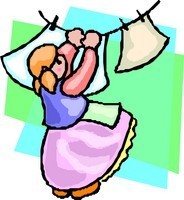 I think hanging clothes to dry after washing is probably the cheapest way possible to save money and to help help the environment.
I think hanging clothes to dry after washing is probably the cheapest way possible to save money and to help help the environment. That's why last week I found myself outside, hanging clothes on the line by moonlight. I had stuck a flashlight in my coat pocket before going outside but found the moon was still up in the west, just a few days past full with plenty of light once my eyes had adjusted to the pre-dawn, pale luminescence of the waning moon.
It was 30 degrees Fahrenheit, but the highs for the day were expected to be in the 50's with no rain and few clouds. There was a slight breeze, so I was glad I'd donned my coat, and my fingers felt the cold nip of the fall as I worked with the wet clothes.
It was pure bliss, though.
I love the early morning time, the silence before the activity of the day, the feeling of new beginnings and possibilities. I feel a sense of optimism; I feel as if I am catching a wave of clean and purifying energy straight from the source of all the laws of nature.
Yes, I'm a morning person . . . and have been accused of being just a tad bit too "perky" when I jump out of bed in the morning. I try not to bring early-morning offense, but sometimes I forget myself and have to wipe that too-cheery smile off my face as I turn down the lights. I make up for it, though, by fixing tea for my wife in the morning. I may be cheery, but I'm cheerfully handing her a cup of tea, carefully timed to hit her hand the moment her feet touch the floor.
Hanging clothes by moonlight is pretty safe, though. The clothes don't mind if I smile and even spin them in a little dance on their way to the line and morning breeze. They don't mind how much I enjoy the soft radiance of the moon high in the west and the lightening of the horizon to the east. Let the birds sing into the silence and the smell of dew on the grasses remind me of the beautiful possibilities building for the day . . . because it is a beautiful day: I have people who love me and to love. I'm healthy and have good work to do. I'm a lucky man.
Come to think of it, hanging clothes by moonlight isn't a pleasant chore; it's a most beneficial recreation.
Copyright 2012 by Thomas L. Kepler, all rights reserved
Published on November 04, 2012 03:26
November 2, 2012
Book Review: Zane Grey's Forlorn River and Nevada
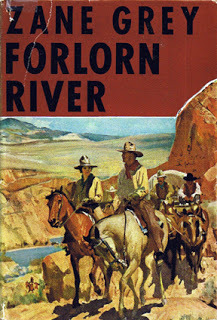 First Edition CoverForlorn River and its sequel, Nevada, are my two favorite Zane Grey novels.
First Edition CoverForlorn River and its sequel, Nevada, are my two favorite Zane Grey novels.I find these novels brimming with Grey's loving descriptions of frontier wilderness. They also maintain Grey's tradition of simplifying characterization to maximize the epic qualities of all people trying to lead good lives in the face of evil.
I like to escape into these novels--and it's easier with these two novels in particular because the cultural biases present in Grey's lifetime are not as prevalent in these novels as in others, even though they are present.
Women are more sensitive, insightful, and intuitive than men. This attitude is really a slam against both men and women. In these novels, though, the women characters come across as very strong and the men as capable of love and loyalty."Injuns and Greasers": Minorities get minimized by Zane Grey, and that is true in this novel also, yet to a lesser degree. One minor character, "Modoc," has a significant role in the novel."Steely-eyed Mormon men": Hidden wives and bold-eyed Mormon men are given a pass-through in the novel as the protagonists pass through a Mormon town with their wagons.Both novels follow the same plotline. Good people are conned by bad people, eventually to be saved by a good man who possesses a hidden, bad past--and a large, deadly pistol.
In Forlorn River (published in 1927), young Ben Ide is cast out by his rich dad, branded a wild horse hunter and possible rustler. Ide befriends a wounded man, whom he nicknames "Nevada." Ide does the same for "Modoc," an Indian he pulls out of a saloon. All three men form bonds of loyalty in their isolated state as they hunt wild horses in the California wilderness.
Meanwhile, as in all romances, there is romance. Ina Blaine comes back from college with a degree of sophistication and independence that her parents find disturbing. She hasn't forgotten her early values, though--or Ben. In addition to this, Hettie Ide, sixteen years old, finds the mysterious Nevada to be tall, dark, and handsome.
In Nevada (published in 1928), another romantic couple comes along, Marvie Blaine, and the daughter of backwoods rustlers, Rose Hatt. The primary action of this novel is in Arizona, where the forces of good and evil clash as honest ranchers are threatened by pernicious rustlers. All conflicts are resolved, and lovingkindness breaks out at the end of the novel--after the gunfight.
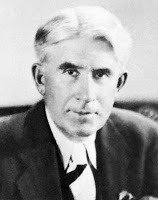 Zane GreyIn the biographical material at the end of Nevada (Thorndike edition), Loren Grey, Zane Grey's son, is quoted as saying, "There was so much unexpressed feeling that could not be entirely portrayed that, in later years, [Zane Grey] would weep when reading one of his own books."
Zane GreyIn the biographical material at the end of Nevada (Thorndike edition), Loren Grey, Zane Grey's son, is quoted as saying, "There was so much unexpressed feeling that could not be entirely portrayed that, in later years, [Zane Grey] would weep when reading one of his own books."The Thorndike edition biography also states, "Zane Grey was not a realistic writer, but rather one who charted the interiors of the soul through encounters with the wilderness."
The fact that those souls he charted were white, Anglo-Saxon souls wears thin about a hundred years after the writing. The cultural landscapes are always too lily white, even within the beautifully painted descriptions of the American frontier wilderness. Forlorn River and Nevada do not project so obviously the prejudices of the time--or rather do so within the context of main characters stepping beyond or around those stereotypes.
Mostly, though, I like how even a hundred years ago, in the end, goodness and happiness can prevail.
Copyright 2012 by Thomas L. Kepler, all rights reserved
Published on November 02, 2012 02:02



